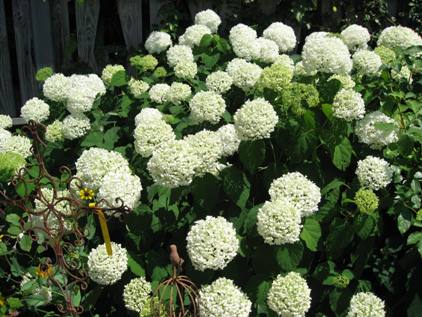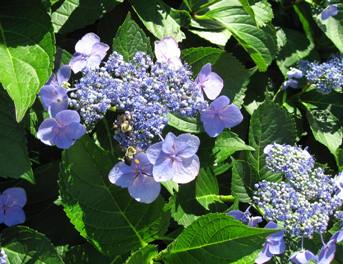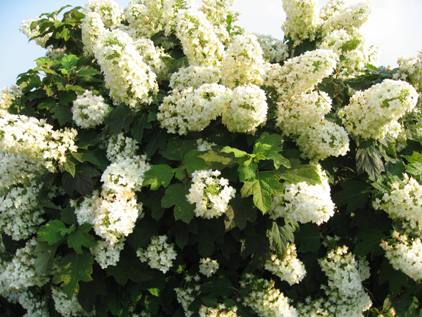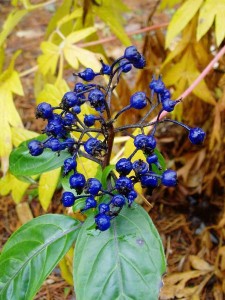Petals from the Past
Monthly Garden Gossip
June, 2011
Welcome to our garden! We're proud of our hard work and want to share the reward with you, so here is what's going on in the garden this month....
Central Alabama
It is time for blueberry pies and blackberry cobblers once again. The U-pick blackberry fields are open and the U-pick blueberries will be open on Saturday, June 4. We encourage you to join us for the Black and Blue Berry Festival on Saturday June 18. There will be music by the Whistle Stop Combo from 10:00am to 12:00. There will be a petting zoo and pony rides as well as lots and lots of black and blueberries to pick. Dr. Arlie Powell well be hosting two seminars on growing black and blueberries one at 10:0am and the other at 12:00. If you haven't planted these easy to grow fruits you are missing out on a treat. They can be planted most any time of year as long as you are able to keep them watered during the dry season. As far as maintenance, at this time of year, there is nothing to be done with either of these plants until the harvest is finished. Once finished picking, you may prune your blueberries to control the size and to raise the 'skirt', the lower branches that lie on the ground when full of fruit. It is a good idea to fertilize again to promote new growth for next year's crop. Blackberries will start putting up new primocanes; remove them as they appear so they do not interfere with picking. Once finished picking, remove all canes that fruited this year and start over trellising them by choosing two new canes and training them on your wires. Fertilize at this time to promote new growth. Watch Dr. Powell's blackberry pruning video on our website for a complete guide to pruni |
i
Keep in mind that the U-pick fields will be closed from June13-June 17 to make sure that we have berries for the Festival. However, already picked berries will be for sale at the retail shop. |
| Better get those tomato plants in the ground if you haven's already.There will be tomato plants available at the retail shop all summer so you can plant any time. You can always start from seed but this will be considered a fall crop by the time the seedlings are big enough to plant in the garden. Of course you can always take a cutting from the tomatoes you like best and root them. They root very easily. Place in a container of potting soil in a partially shady spot for a couple ofdays, keep moist and they will root. Now you have a new plant. Don't forget about the Tomato Contest on July 9, details are on the Event Page and you can print an entry form there also. We changed the date and made it earlier this year so maybe there will be lots of tomatoes available to judge. |
Juliet and Better Bush Tomatoes |
| Be on the look out for cabbage loopers and tomato hornworms. They can ruin your crop in a very short time. Use Dipel dust or Sevin to control these pests. Pumpkins should be planted before July 4. Squash, okra, corn, beans and cucumbers can still be planted |
| Don't forget to plant some herbs to go along with all the vegetables you will harvest from the garden. Basil, parsley, oregano, thyme and rosemary are a must but consider some of the other herbs as well. Agastache has a wonderful licorice scent and beautiful flowers. Loveage is celery scented and can be used to replace celery in some recipes. Try your hand at Stevia, a natural sweetener for your tea or coffee. Lemon Grass, while not always perennial here, is great to have if you are a fan of Thai cuisine. Texas tarragon is a good replacement for French tarragon which is a little fussy about growing in our hot humid climate. There are a host of others not to mention the 8 or 9 different kinds of mint that we offer. |
Hydrangeas for every spot in your garden sun, shade or both! I grow the Oakleaf Hydrangea Snowflake in full blazing sun. It flowers wonderfully. However, the leaves turn burgundy in the heat of the summer and frankly the plant doesn't look that great. But... I don't have any choices, there is no shady location for this plant in my garden. They do just fine but would look a little better in the summer if there was shade. The Annabelle Hydrangea will grow and flower in full sun as well as partial shade. The Bluebird Hydrangea, which is a lacecap, which means, only the outer flowers open the center ones are sterile and remain closed. It needs partial shade, morning sun perferabally with afternoon shade. Ours at the shop recieves morning sun up to 2:00pm but sometimes in the afternoon looks a little wilted but when the shade finally comes it recovers. If you thought you didn't have a place in your garden for hydrangea take another look. |
Annabelle Hydrangea |
Bluebird Hydrangea, a Lacecap |
Snowflake Hydrangea |
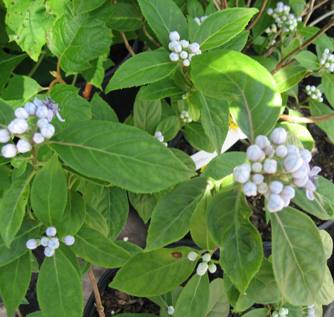 |
Evergreen Hydrangea Drichroa frebrifugaThis evergreen hydrangea has flowers that open to pinkish to blue from June to August followed by metallic blue berries. The flowers are PH sensitive and the best blue color is formed when the plants are in acid soil. They like regular water and protection from the hot afternoon sun. Will tolerate shade and grows to be 6 to 8 feet tall. Responds to pruning. . |
Coming This Fall"Amber Blush" was discovered as a naturally occurring seedling growing on a sandy levee along Weaver. River in Santa Rosa County, Florida by Rick J. Lewandowski (Mt. Cuba Center), Fred Spicer (Birmingham Botanical Gardens), and Ron Miller, a noted native azalea authority and Florida resident. Amber Blush calamint represents the first joint introduction from Mt. Cuba Center and Birmingham Botanical Gardens.As flower buds develop, they are a rich golden yellow color. Upon opening, faint reddish streaks are evident on the lower inside lip of the flower and the exterior tube, giving 'Amber Blush' its namesake color. This characteristic is particularly prominent on plants flowering late in the growing season. Amber Blush calamint is a fast growing, multi-stemmed, semi-evergreen drought-tolerant shrub with aromatic grayish green leaves. While the mature size of 'Amber Blush' has yet to be determined, the species is irregularly spreading, typically reaching 2' to 4' tall and 2' to 3' wide at maturity. 'Amber Blush' prefers excellent drainage, full sun, and acidic soils. With winter drainage it is reliably hardy in USDA zones 7A-8A. Efforts to overwinter this plant in 6B have proven unsuccessful thus far. Flowering occurs in profusion on current season's growth from summer through late fall. As with many other members of the mint family, Amber Blush calamint should be pruned during active growth. Petals from the past has been chosen to propagate this plant and it will be for sale this fall so be on the look out for this new introduction.
|
| Prune arborvitaes, evergreen shrubs and trees of the cypress family, juniper, yew and hemlock for shape after their main spring growth is complete. You can still prune your spring flowering shrubs but you better hurry. Once complete give them some fertilizer to get some new growth. Continue to mulch your planting beds with shredded pine bark mulch to conserve water and prevent weeds. It is best to use pine straw on slopes since the pine bark may wash away in a rain. |
| Check your apples and pears for fire blight. This bacterial disease causes the leaves and new shoots to turn brown or black and appear as if burned. If you find any, cut out the branches about 4" below the infected area, making sure to disinfect your clippers each time you make a cut. Use a 10% clorox solution. This reduces your chances of spreading the disease. | Green House Sale Don't forget about our Greenhouse sale on June 25, 7:00am to 2:00pm This is the sale of the year ! We offer all our plants in the greenhouse growing areas at wholesale prices. If you are planning to do some additional landscaping this would be the sale for you. Many of the plants at the retail shop are also on sale as well as the accessory items such as the pottery and yard art. |
| Looking for a little summer color? Try Zinnias. The butterflies love them and they grow quickly and easily. Simply throw some zinnia seed in your border, making sure the seeds make good contact with the soil and water in. Soon there will be enough flowers to cut a bouquet for the table and enough for the butterflies. |

